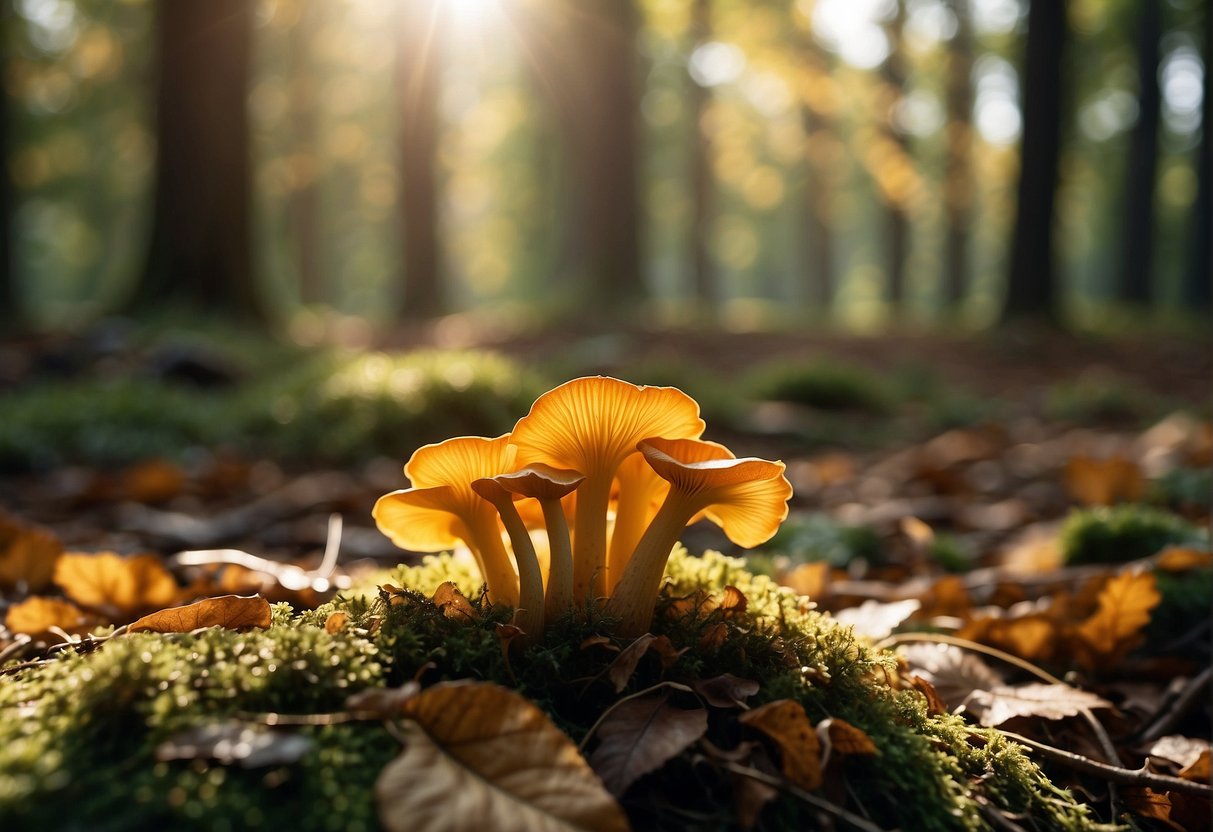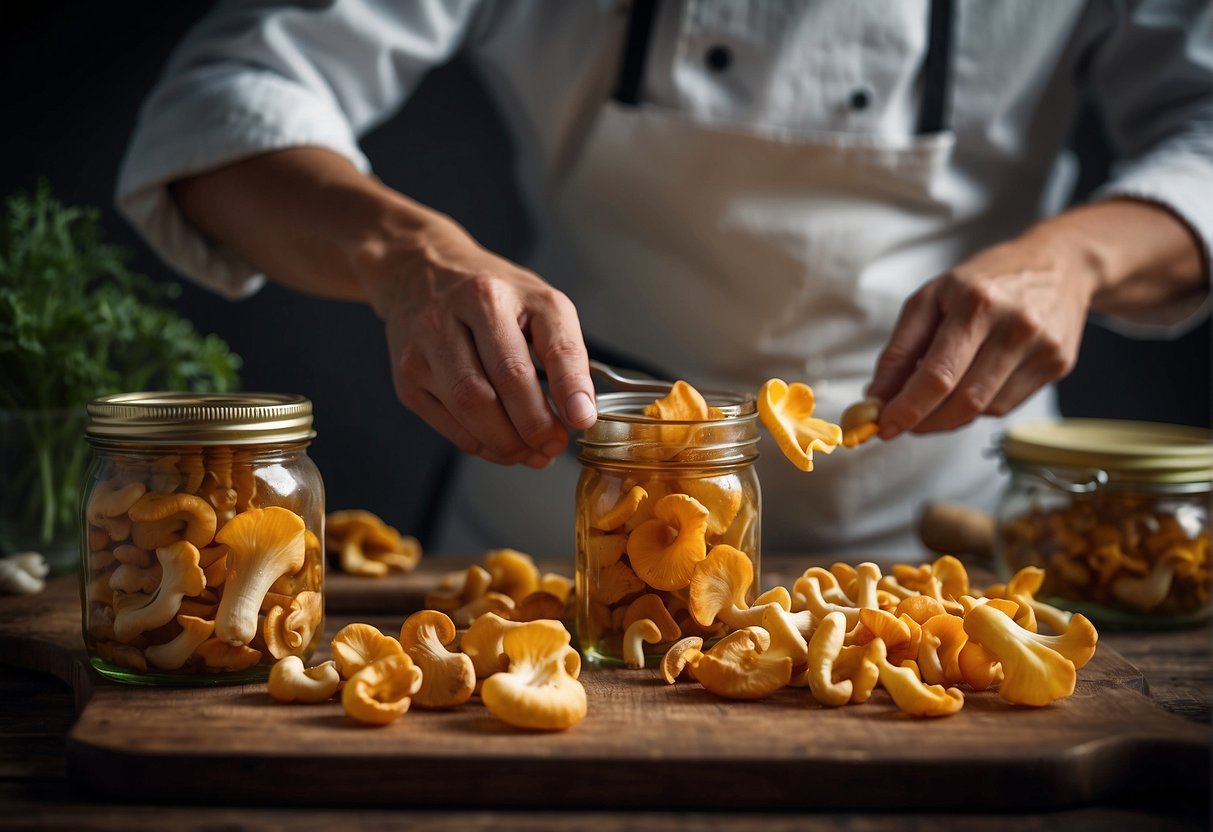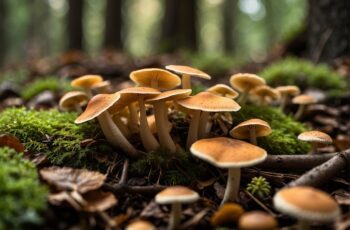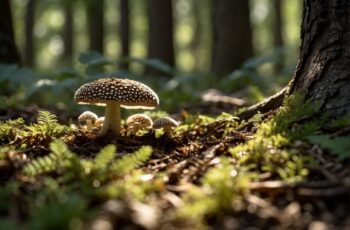Chanterelle mushrooms are a prized find for foragers due to their distinctive appearance and delicious taste. Recognizing these golden-hued fungi correctly is crucial as they do have some look-alikes that are not edible. When you set out to identify chanterelles, your main visual cues will be the color and shape of the mushroom. Typically, chanterelles have a vibrant yellow to orange color, reminiscent of autumn leaves, and their caps are shaped like an inverted cone or a vase.

The chanterelle’s stem is solid and shares the same color as the cap, without any rings or markings. Unlike some other mushroom varieties, chanterelles do not have a separate cap and stem but rather appear to be a single, smooth structure. The underside of the cap features gill-like ridges that are forked and run down the stem, but these are not true gills—they are blunt and merge with the stem. When handled, the flesh of the chanterelle is white or pale yellow and emits a subtly fruity aroma, often compared to apricots. By familiarizing yourself with these traits, your foraging for chanterelle mushrooms will be rewarding and safe.
Feel confident in your ability to distinguish these flavorful mushrooms from their non-edible counterparts. Critical factors such as the environment where they grow can also aid in identification; chanterelles typically thrive in damp, mossy forests and are often found in a symbiotic relationship with certain tree species like oaks and conifers. Remember to enjoy the process of foraging as much as the culinary delights chanterelles can offer in your kitchen.
Identifying Characteristic Features of Chanterelles
Chanterelle mushrooms, such as the coveted Cantharellus cibarius, are renowned for their distinct features. Recognizing these characteristics ensures accurate identification and safe foraging.
Cap Characteristics
Cap Shape & Texture: Chanterelle caps typically have a wavy and sometimes lobed edge, appearing somewhat like a trumpet or funnel. The texture is often smooth to slightly velvety. Golden chanterelles are known for their shallow, vase-like caps.
Stem and Gills
Stem: The sturdy stem of chanterelles is usually the same vibrant color as the cap, blending seamlessly. False gills: are a hallmark, appearing as forked and blunt ridges running partway down the stem, unlike the sharper true gills of other mushrooms.
Scent and Texture
Aroma: Your nose knows; chanterelles emit a pleasant, fruity smell, sometimes compared to apricots.
Texture: The flesh should be firm and white when cut, offering a slight give under pressure—not mushy or woefully soft.
Color Variations
Variants: Spanning from yellow to deep orange, the color of chanterelles can hint at the type you’ve found: yellow chanterelles, golden chanterelles, or the rarer red chanterelles. Each has a vibrant, but not neon, hue that stands out in the forest underbrush.
Habitats and Growth Patterns
When you’re on the lookout for chanterelle mushrooms, understanding where to find them and recognizing their unique growing patterns are key. These mushrooms are picky about where they pop up and have a distinct relationship with their environment.
Preferred Habitats
Chanterelles flourish in a range of forest types but show a strong preference for hardwood forests. You’ll often find them carpeting the floor of oak, beech, or birch woodlands. However, don’t overlook coniferous forests; they’re known to cohabit with conifers as well. The forest floor is prime real estate for chanterelles, thanks to the moist, well-draining soil that supports their growth.
Symbiotic Relationships
One of the reasons you find chanterelles in these environments is due to their mycorrhizal relationships with trees. These fungi form a mutually beneficial bond with tree roots, allowing the exchange of nutrients. The chanterelle partners with various host trees, so check around living tree roots where these mycorrhizal fungi are likely to occur.
Fruiting and Seasons
Chanterelles make their grand appearance in the rainy seasons, generally summer to fall. This is the best time to forage chanterelles, so plan your mushroom hunting after ample rainfall when the forest floor is damp but not waterlogged. Keep in mind that summer mushrooms like chanterelles follow these fruiting patterns consistently, making them a seasonal delicacy not to be missed.
Foraging Tips and Safety
When foraging chanterelles, your safety hinges on accurate identification and understanding of mushroom ecology. Equip yourself with the knowledge to differentiate edible varieties from toxic look-alikes.
How to Forage
When you head out to forage chanterelles, always remember the golden rule: only harvest mushrooms you can positively identify. Start your journey by researching the habitat where chanterelles thrive—usually in moist, hardwood forests, often near mossy areas. Look for their distinctive golden-yellow color and funnel-shaped caps during the late summer to fall months.
- Time of Day: The early morning after a rainfall can be ideal for foraging, as chanterelles are more visible.
- Equipment Needed: Bring a knife for clean cuts, a basket or mesh bag to allow spores to disperse, and a field guide for on-the-spot reference.
Remember to harvest sparingly, taking only what you need, to ensure that the chanterelles continue to thrive in their natural environment.
Identifying Toxic Look-Alikes
The biggest risk when mushroom foraging is mistaking edible species for toxic ones. The Jack-o-lantern mushroom (Omphalotus illudens) is often confused with chanterelles due to its orange color. However, unlike chanterelles, it possesses sharp gills and a glow-in-the-dark quality.
- False chanterelle (Hygrophoropsis aurantiaca) is another common look-alike. It’s usually brighter orange and has a more symmetric cap.
- Gills: Chanterelles have forked, vein-like ridges, not true gills.
By being meticulous with your identification, you can safely enjoy the fruits of your foraging without the worry of ingesting something harmful. Keep your field guide handy, and when in doubt, consult a local mycologist or a foraging group. Your safety is paramount—never gamble with mushrooms you’re unsure about.
Culinary Uses and Preservation

In the realm of wild mushrooms, chanterelles are a prized find for any forager. Their distinctive flavor can enhance a variety of dishes, while proper preservation ensures you can enjoy these gems year-round.
Cooking Techniques
Chanterelles are revered for their rich, peppery taste and are versatile in the kitchen. A classic method to bring out their flavor is to sauté them in butter with a bit of garlic. This simple, yet effective, method allows the robust flavors of the chanterelle to shine. To achieve the best results:
- Clean your chanterelles by gently brushing off any dirt with a soft brush.
- Heat a pan over medium heat and melt a generous knob of butter.
- Toss in the cleaned mushrooms along with a minced garlic clove.
- Sauté until they are golden brown, usually around 5 to 6 minutes.
Storing and Preservation
Proper storage is crucial for maintaining the quality and extending the shelf life of chanterelles. Immediately after foraging:
- Remove loose dirt by gently brushing the chanterelles.
- Do not wash with water as they can absorb moisture, which leads to spoilage.
- Store them in a paper bag in the refrigerator to keep them fresh for up to 5 days.
For long-term storage, you have the option to dehydrate the mushrooms. Dehydrated chanterelles can last for a couple of years if stored in an airtight container in a cool, dark place. The process involves slicing the mushrooms and arranging them on a dehydrator tray, dehydrating them at a low temperature until completely dry. This method locks in their flavor, making them a valuable addition to your pantry for use in future dishes.


